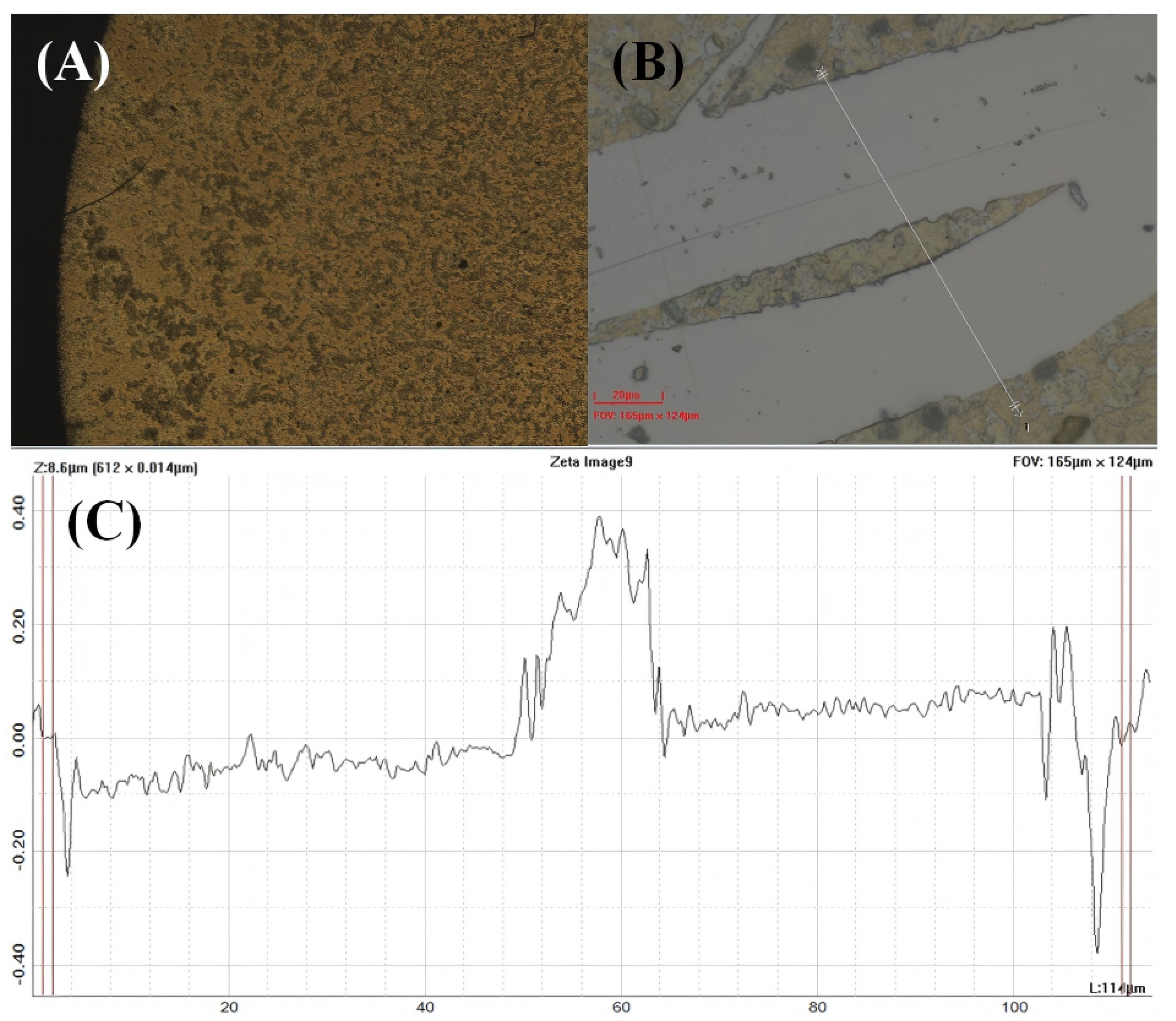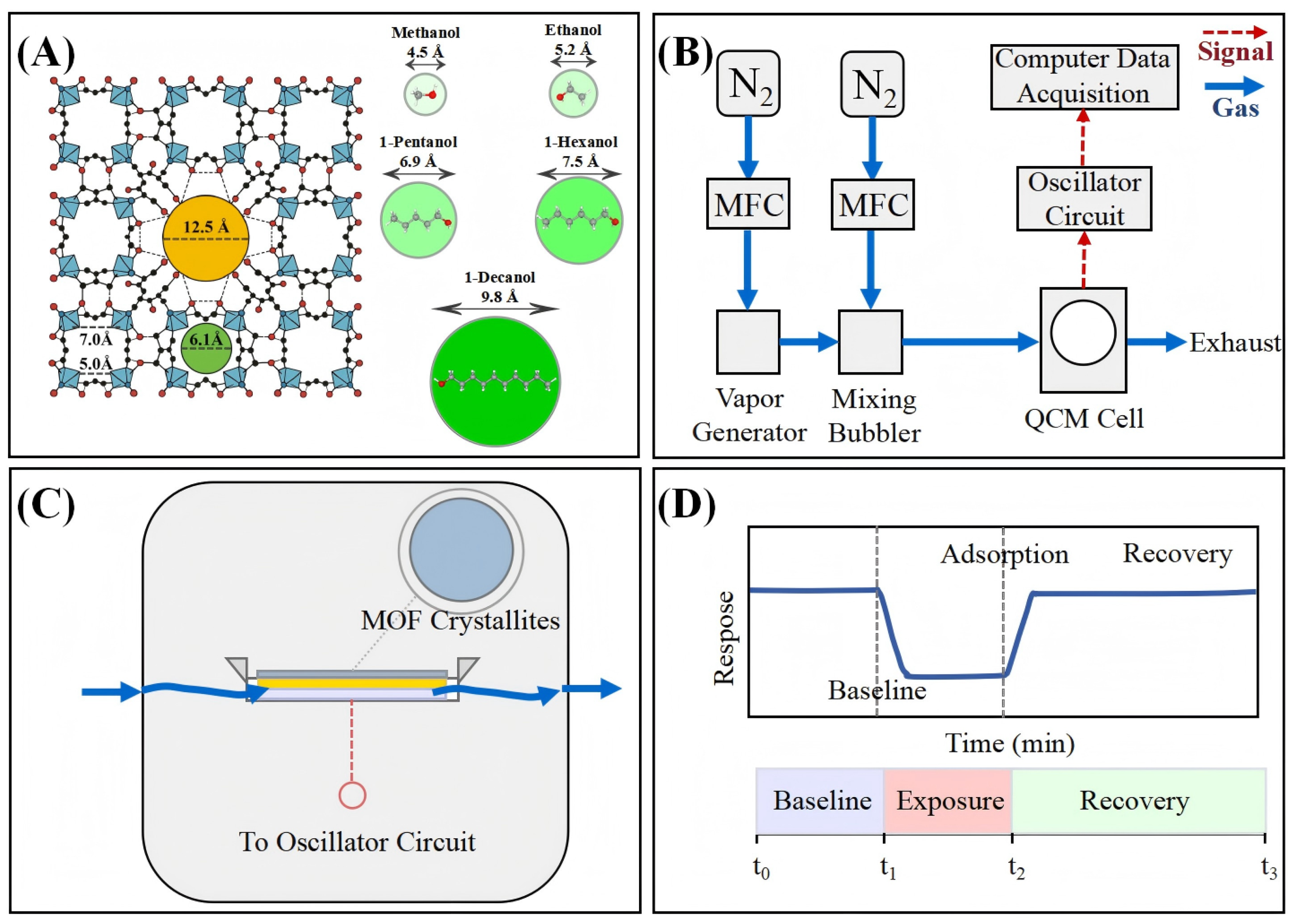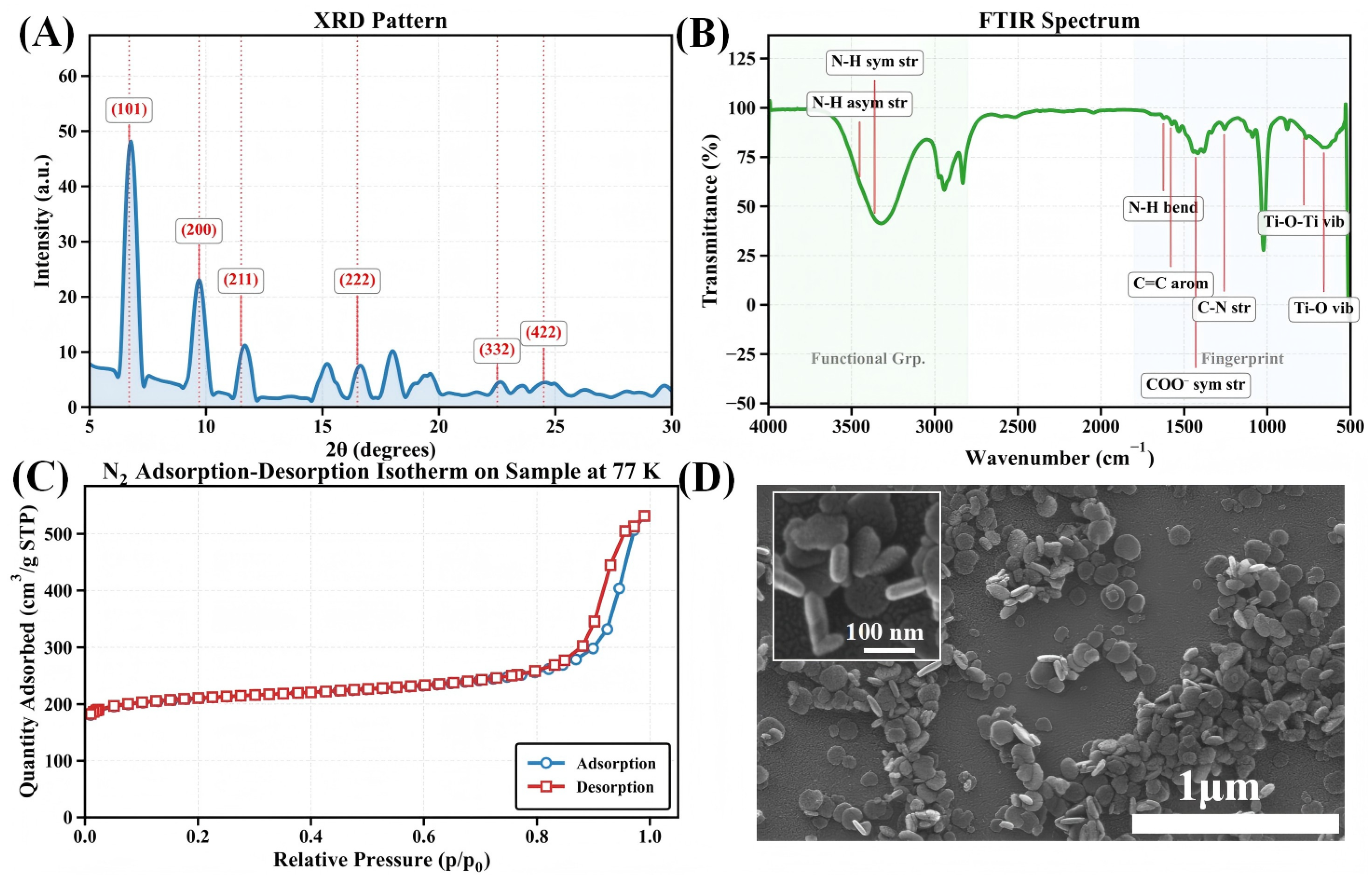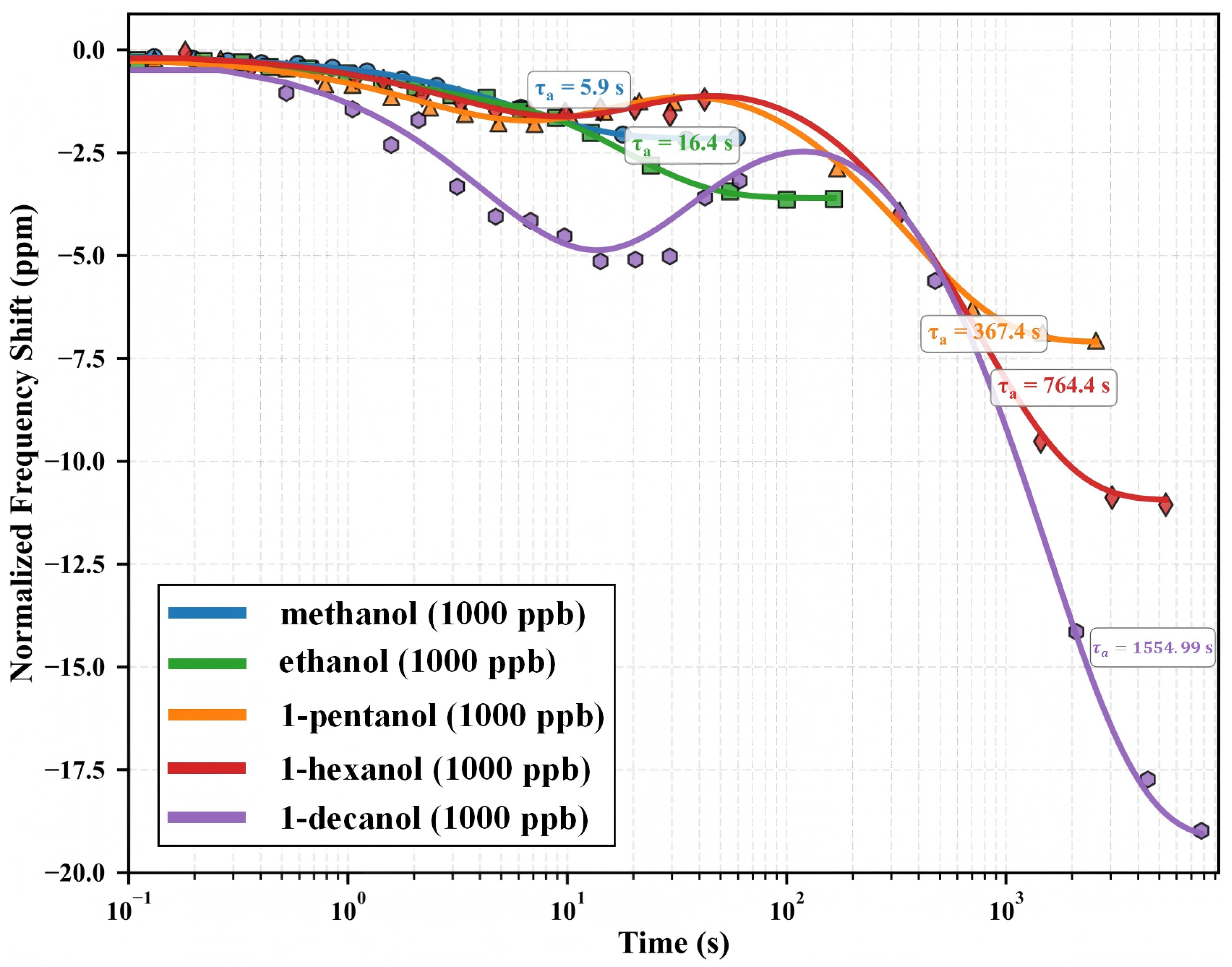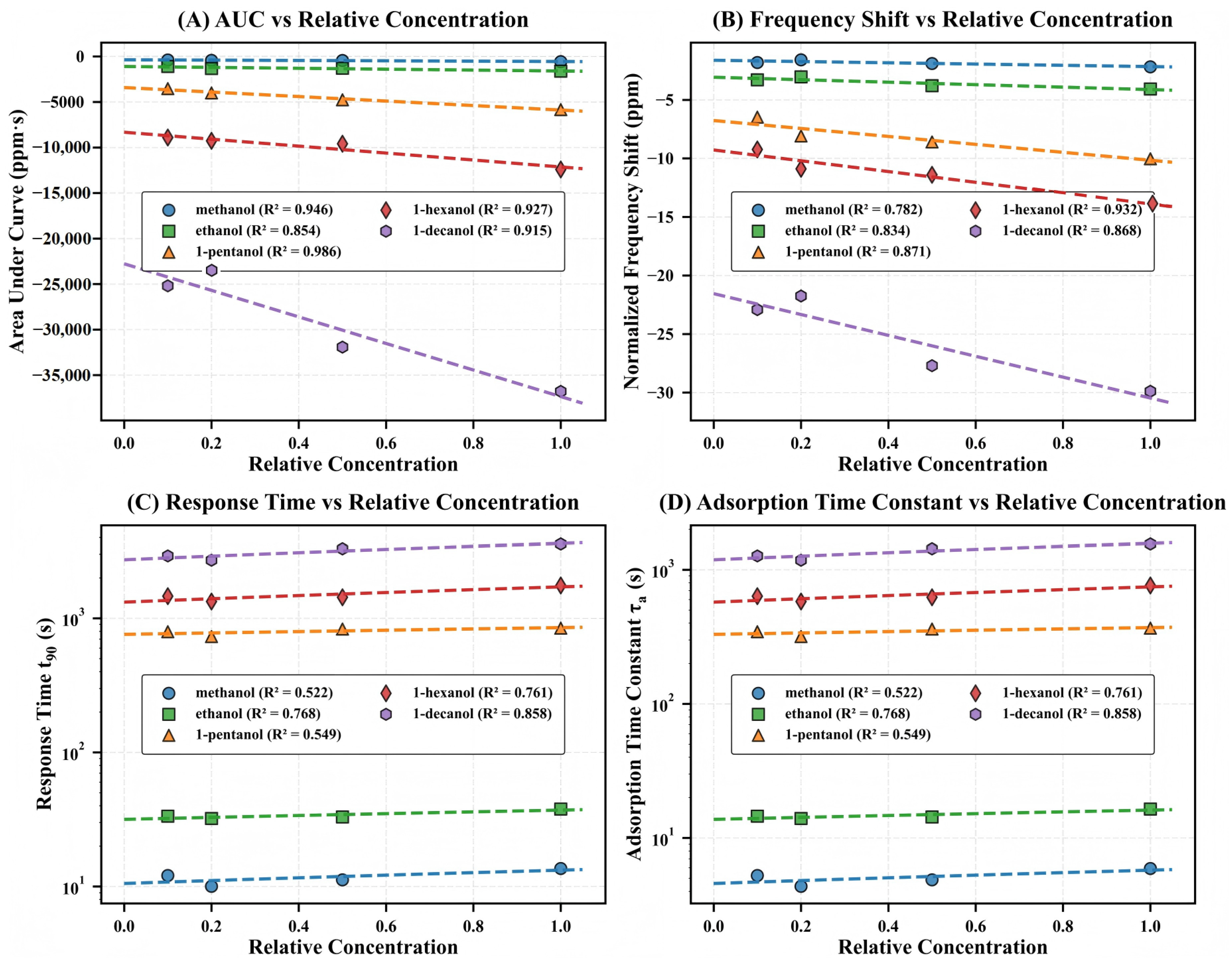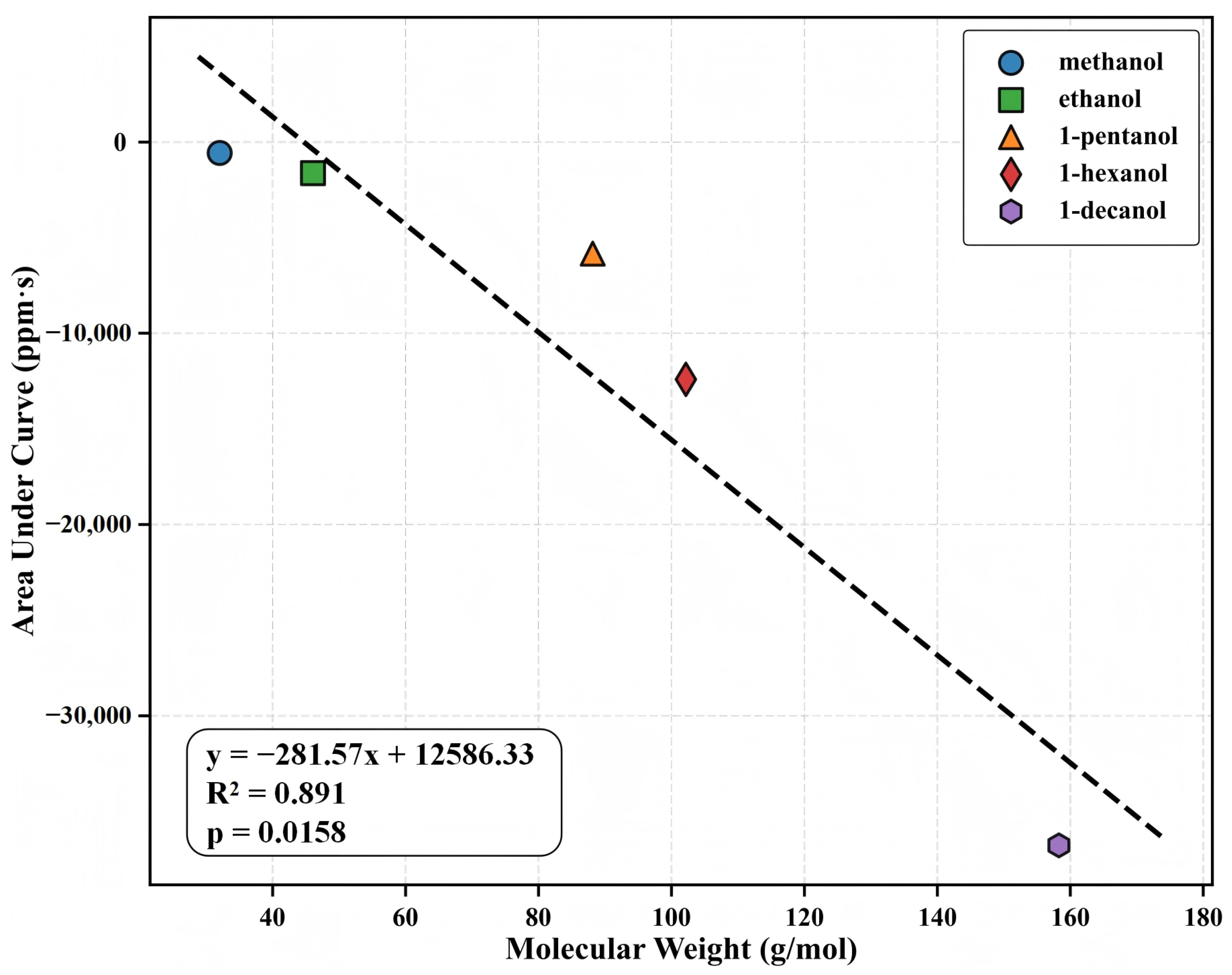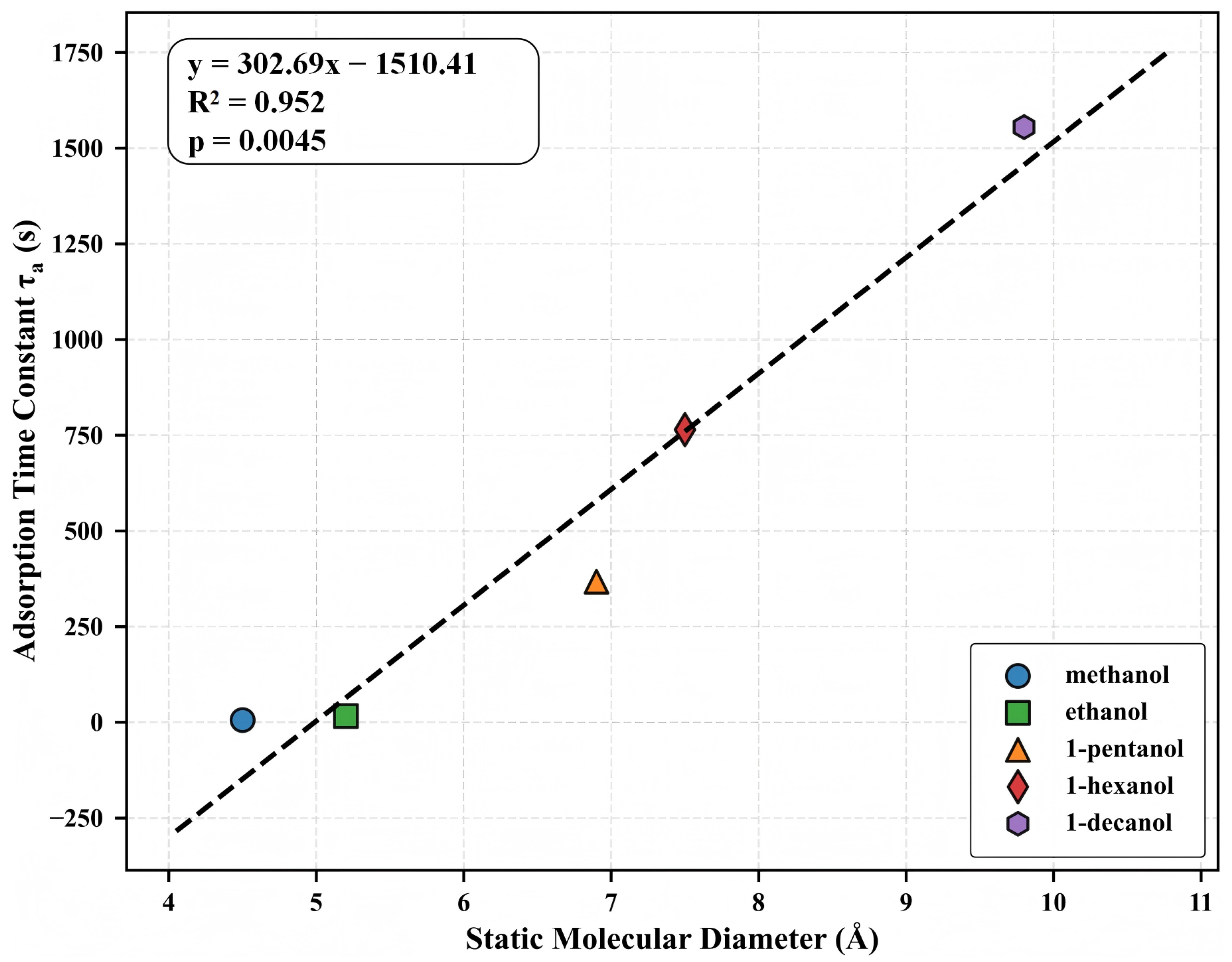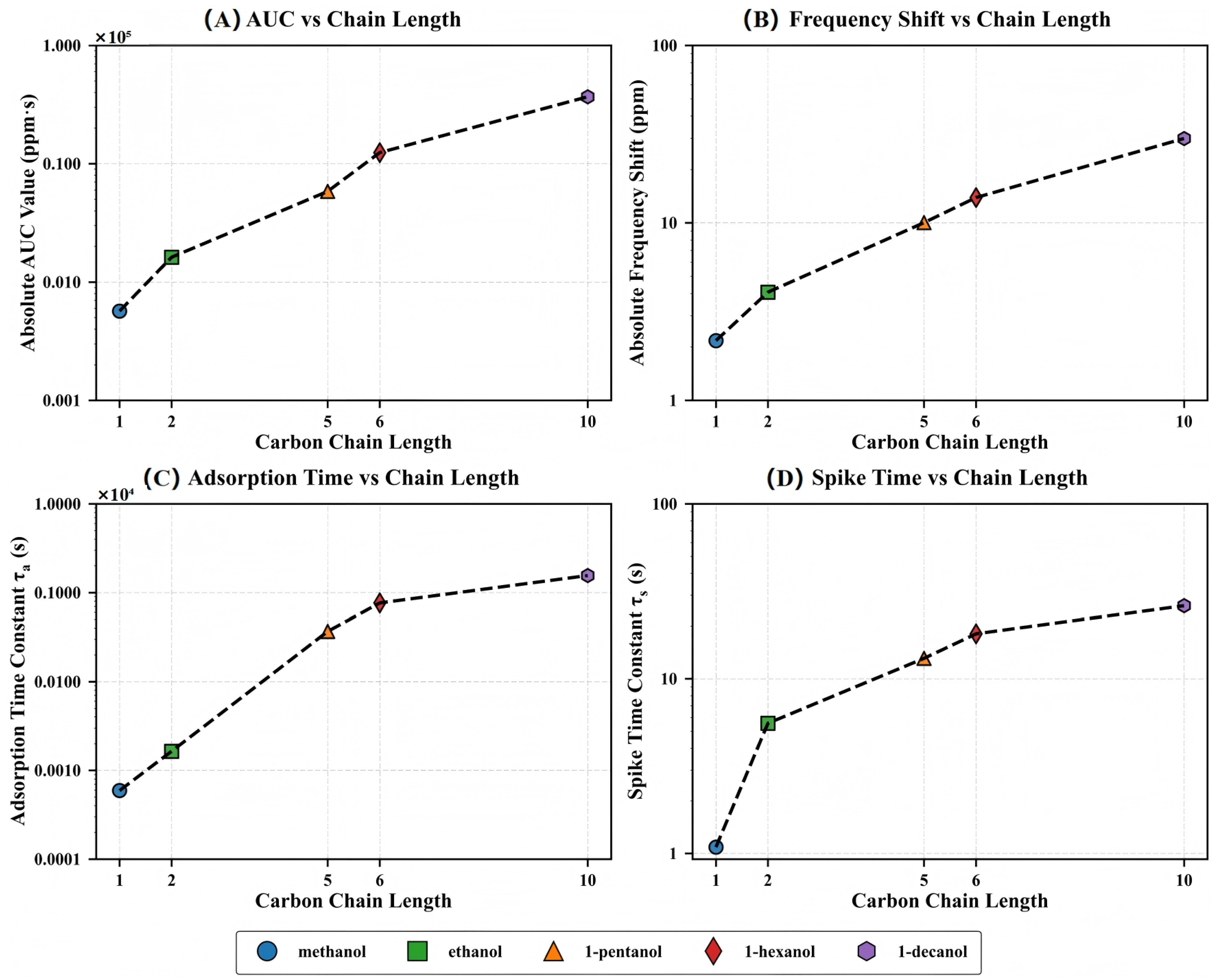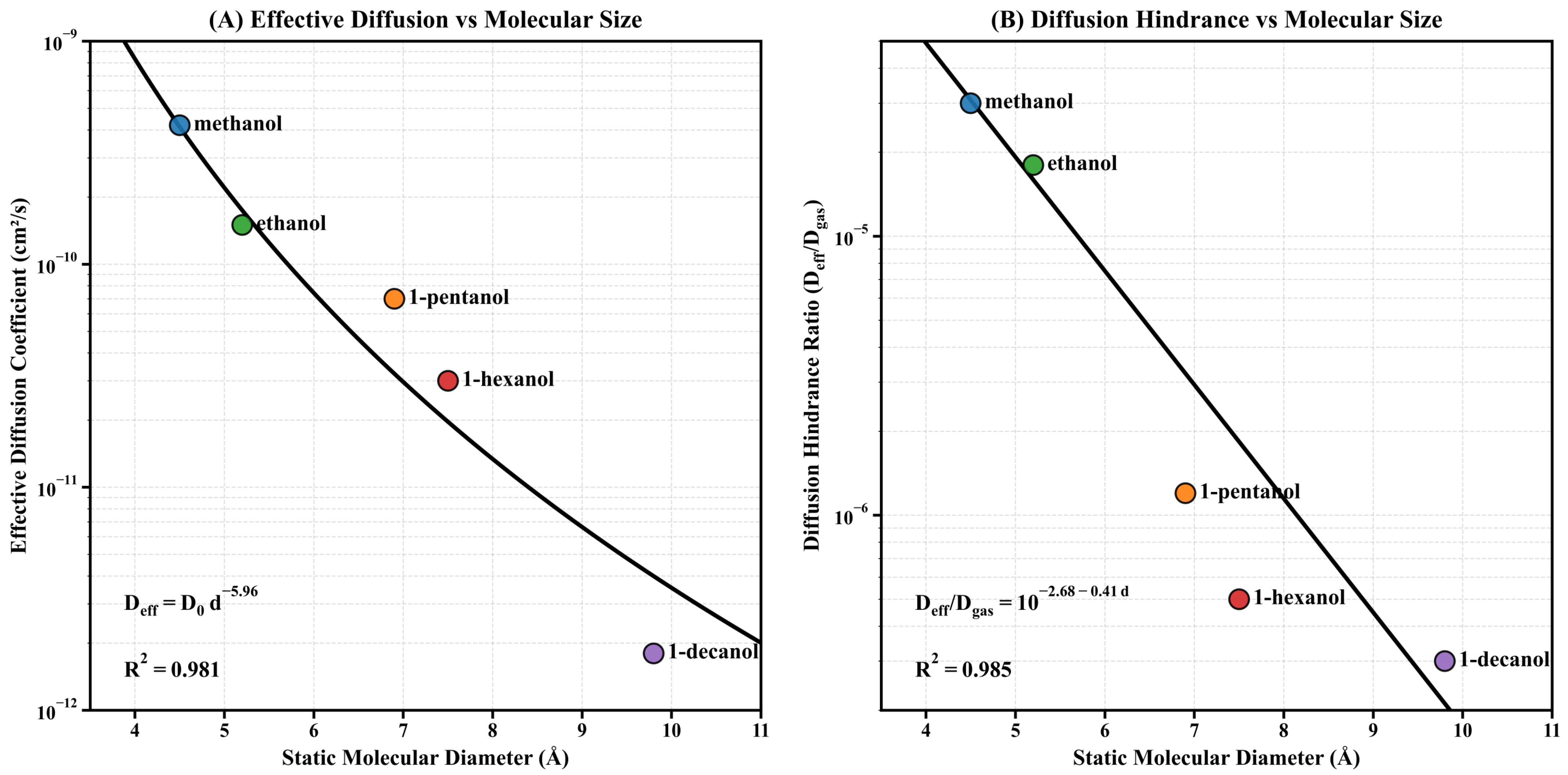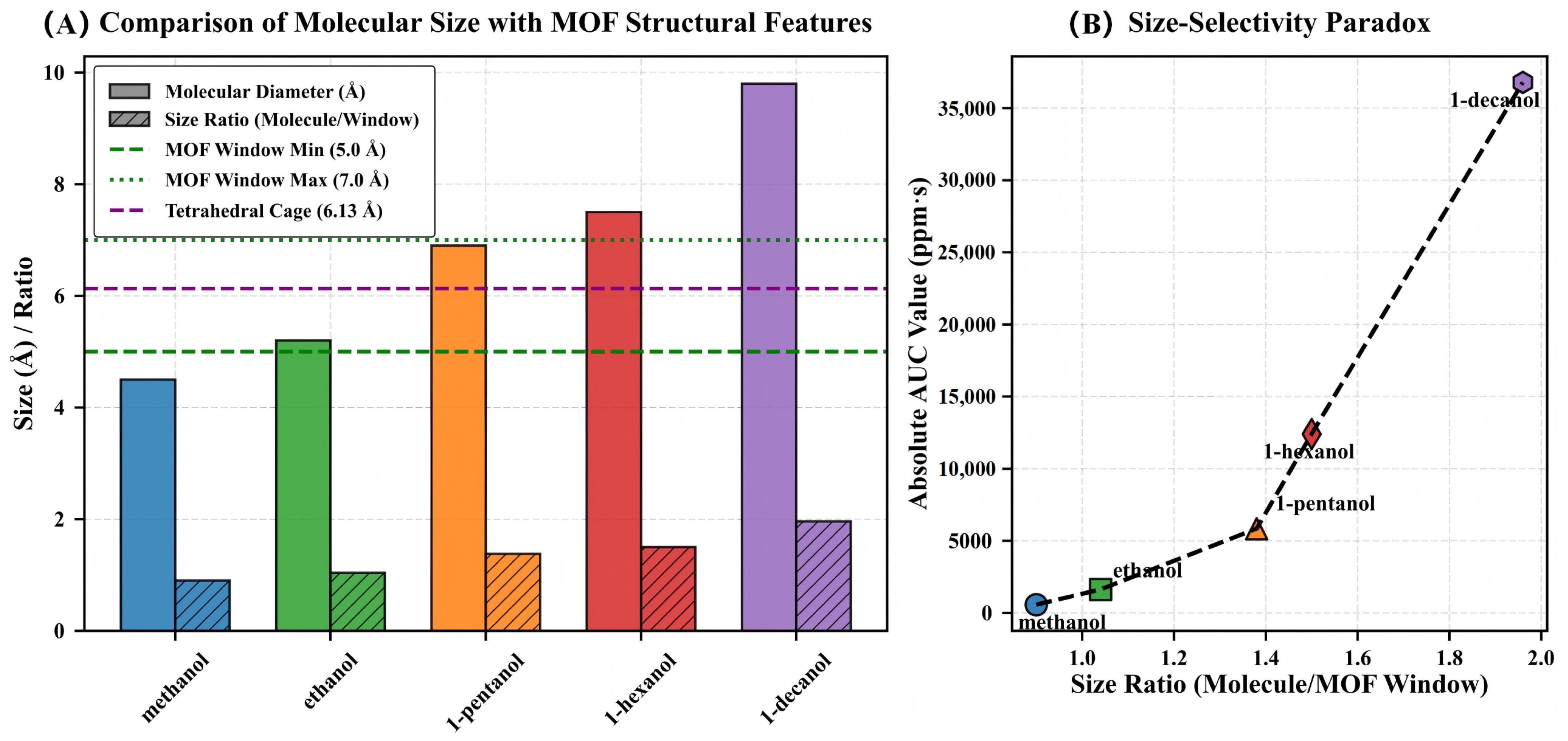1. Introduction
The detection of volatile organic compounds (VOCs) presents critical analytical challenges across various fields, including environmental monitoring [
1], industrial process control [
1], clinical disease diagnosis [
2], and food quality assessment [
3]. In complex matrices, traditional sensing methods face fundamental limitations in terms of sensitivity, selectivity, and stability, particularly when distinguishing structurally similar trace analytes, despite recent technological advancements. These limitations urgently necessitate innovative sensing architectures that transcend conventional detection methods [
4]. By strategically combining improved conversion mechanisms with precision-engineered microporous materials, the development path for next-generation sensing platforms has been broadened to meet the increasingly stringent analytical requirements of a wide range of applications.
Quartz crystal microbalance (QCM) technology, with its nanogram-level mass sensitivity, real-time label-free signal output, and high integration potential, has emerged as an excellent choice for gas sensing applications [
5]. Unlike spectroscopic or electrochemical techniques that often require complex signal conversion pathways, QCM operates based on the direct piezoelectric principle. This principle converts mass adsorption events into precise frequency changes via the Sauerbrey relationship, establishing a direct correlation between quantifiable sensing results and molecular interaction phenomena. Metal–organic frameworks (MOFs) demonstrate exceptional molecular recognition potential in the surface-sensitive layer—a critical component in QCM sensor optimization [
6]. Their modular crystal coordination network structure confers exceptional structural flexibility, enabling precise tuning of adsorption energy, surface functionality, and pore size (0.3–2.0 nm) [
7]. As a result, MOF-based QCMs serve as an ideal platform for studying molecular recognition processes, featuring crystallographically defined binding sites, tunable chemical environments, and extensive surface areas.
The current theoretical framework primarily relies on simplified molecular sieve models, assuming that the kinetic diameter of target molecules must be smaller than the framework pore size to enable effective detection [
8]. Although significant progress has been made in the development of MOF-functionalized QCM sensors as shown in
Table 1, this static geometric model fails to accurately predict experimental observations in many MOF systems [
9]. This is because unexpected enhanced responses often occur when molecular sizes approach or exceed the nominal pore size. Recent studies [
10] have emphasized the importance of understanding the dynamic structure–property relationships in nanocomposite-enabled chemical sensors. This paradigm suggests that, to accurately predict sensing behavior, the framework must integrate structural dynamics, energy considerations, and kinetic factors, as static models have limitations. These findings indicate that molecular recognition in microporous frameworks is not limited to simple size exclusion but is characterized by multifaceted host–guest interactions, including framework flexibility (e.g., ‘breathing’ or ‘gate opening’ phenomena) [
11,
12], specific enthalpic contributions from directed host–guest interactions [
13], synergistic adsorption effects, and contributions from multiple adsorption sites. This understanding necessitates the development of a structure–function mapping framework capable of integrating experimental results (even seemingly contradictory ones) and establishing robust principles for predicting the design of sensing materials.
While other MOF materials have been previously explored for gas sensing applications, MIL-125-NH2 offers unique advantages for alcohol detection that have not been systematically investigated. Unlike copper-based MOFs (e.g., HKUST-1) that can undergo partial degradation in the presence of alcohol vapors, or zinc-based frameworks (e.g., ZIF-8) with limited polar interaction sites, MIL-125-NH2 combines exceptional chemical stability with amino-functionalized pores that can establish specific hydrogen bonding with alcohol hydroxyl groups. Additionally, the photocatalytic properties of MIL-125-NH2 under visible light provide potential for self-regeneration capabilities not present in other MOF systems, which could extend sensor lifetime during prolonged alcohol vapor exposure. These distinctive features, combined with the titanium-based framework’s biocompatibility, make MIL-125-NH2 an ideal yet underexplored candidate for alcohol sensing applications. Based on the following strategic considerations, the representative amino-functionalized titanium MOF material MIL-125-NH2 was selected as the model system. Using a homologous series of primary alcohols (methanol to 1-decanol) as molecular probes with systematic size variation and consistent functional groups, we establish quantitative structure–response relationships by analyzing amplitude, kinetics, and diffusion behavior. Surprisingly, when the molecular size exceeds the framework pore diameter, despite a three-order-of-magnitude decrease in the diffusion coefficient, the response amplitude still significantly increases. Molecular flexibility, framework adaptability, cumulative non-covalent interactions, and multi-domain adsorption form a multi-mechanism model explaining this phenomenon contrary to classical sieving principles. These findings provide an advanced theoretical foundation for developing selective microporous sensing interfaces, whose selectivity arises from the synergistic regulation of diffusion and interactions, surpassing traditional size exclusion principles.
3. Results and Discussion
3.1. Characterization of MIL-125-NH2
The structures of the MIL-125-NH
2 samples were confirmed by a series of complementary characterization techniques. Powder X-ray diffraction (PXRD) patterns (
Figure 2A) exhibit the characteristic peaks of the tetragonal phase (space group I4/mmm), with the primary reflection at
(101), and additional peaks at
(200),
(211), and
(222), indicating high phase purity and crystallinity. Fourier-transform infrared spectroscopy (FTIR) (
Figure 2B) further corroborated the framework structure, showing N–H stretching at 3400–3300 c
, N–H bending at ∼1625 c
, and characteristic aromatic C=C, C–N, C–O, and Ti–O vibrational bands, thus confirming retention of organic ligands and formation of Ti–O clusters.
Nitrogen adsorption–desorption isotherms at 77 K (
Figure 2C) reveal a pronounced microporosity with a Brunauer–Emmett–Teller (BET) specific surface area of 678
/g. The isotherm displays combined Type I/IV features: micropore filling at low relative pressures and capillary condensation hysteresis at higher pressures, suggesting secondary mesoporosity (e.g., inter-crystalline voids or defects) alongside dominant micropores. In
Figure 2D, Scanning electron microscopy (SEM) shows disc-shaped microcrystals with a uniform size distribution of 80–120 nm, consistent with reported morphology. Overall, MIL-125-NH
2 demonstrates high crystallinity, well-defined functional groups, and excellent porosity and topographic homogeneity, providing a robust structural basis for its use as a QCM sensor coating.
3.2. Characteristic Response Profiles and Model Fitting
The MIL-125-NH
2-functionalized QCM sensor demonstrates unique molecular size-dependent adsorption kinetics for alcohol homologs.
Figure 3 shows adsorption profiles as normalized frequency shifts versus logarithmic time. Each curve represents an individual adsorption experiment at an analogous concentration (1000 ppb). The logarithmic time representation allows for complete viewing of adsorption processes across many timeframes (
–
s). Adsorption begins at the rightmost data point for each homolog and moves leftward over time until equilibrium is reached. This picture emphasizes two key observations: (1) equilibrium frequency shifts rise systematically with molecular weight, and (2) equilibration periods grow drastically with increasing molecular dimensions.
The adsorption profiles show a basic disparity in behavior across the homologous series. Lower molecular weight alcohols (methanol, ethanol) with diameters (4.5–5.2 Å) comparable to the framework’s minimal pore aperture (5.0 Å) show rapid equilibration (
–
s) and mild frequency shifts (–2.17 to –3.51 ppm). In contrast, higher homologs (1-pentanol, 1-hexanol, 1-decanol) with dimensions exceeding the framework windows demonstrate dramatically extended equilibration times (
–
s) coupled with substantially enhanced frequency shifts (–7.21 to –19.56 ppm). This counterintuitive relationship—larger molecules generating stronger responses despite severe diffusion limitations—provides the first experimental evidence for the ‘size-selectivity paradox’ explored in detail in
Section 3.7.
The modified adsorption model accurately captures complex dynamics (, RMSE ppm) for all molecular species. Model parameter analysis shows that the ratio of adsorption amplitude to time constant () declines with molecular size, indicating a balance between thermodynamic driving forces and kinetic limits. The 263-fold rise in from methanol to 1-decanol demonstrates MIL-125-NH2’s excellent molecular discrimination capabilities in the temporal domain, confirming time-resolved detection as a potent complementary technique to classic equilibrium-based approaches.
3.3. Concentration-Dependent Response Characteristics
To establish a quantitative correspondence between the concentration of analytes and the response of QCM, this study systematically evaluated alcohol homologs across multiple concentration gradients, analyzing four critical sensing parameters, as shown in
Figure 4. The amplitude parameters (AUC and
,
Figure 4A,B) exhibit exceptional linearity with concentration (
–
) and systematic enhancement with molecular weight. AUC values for methanol and 1-decanol increase by approximately 37-fold at maximum concentration, from approximately –1000 ppm·s to –37,000 ppm·s. This increase is significantly greater than the 4.9-fold ratio of their molecular weights. This disproportionate amplification offers quantitative evidence that molecular recognition factors, in addition to simple mass loading, substantially influence the sensing response.
In striking contrast, the kinetic parameters (
and
,
Figure 4C,D) segregate into two distinct domains—small alcohols (10–40 s range) versus large alcohols (300–2000 s range)—with minimal overlap. These parameters show more modest concentration dependence (
–
) and span more than two orders of magnitude on a logarithmic scale, indicating that molecular transport through the microporous framework is governed primarily by structural compatibility rather than concentration gradients.
The contrasting behavior of amplitude versus kinetic parameters reveals the fundamental sensing mechanism of the MIL-125-NH
2 system. The systematically increasing slopes in
Figure 4A,B quantitatively demonstrate that larger molecules generate proportionally stronger responses despite their diffusion limitations—the key phenomenological signature of the size-selectivity paradox. AUC sensitivity is approximately 37-fold higher in 1-decanol than in methanol, although it necessitates a 263-fold longer equilibration time. This is compelling evidence that the kinetic penalties of larger molecules are substantially outweighed by the enhanced thermodynamic driving forces.
These calibration relationships simultaneously offer theoretical explanations for the molecular recognition properties of the MIL-125-NH2-QCM system and establish a robust analytical foundation. In practical sensing applications, the amplitude parameters provide exceptional linearity and superior concentration sensitivity, while the dramatic temporal differentiation observed in the kinetic parameters offers a complementary dimension for molecular discrimination based on diffusion dynamics.
To obtain the detection limit (LOD) for each alcohol homolog, the value of LOD was derived from the standard
method and the concentration-dependent calibration curve depicted in
Figure 4B. The analysis results indicate a distinct negative correlation between molecular weight and LOD, with values decreasing in the following order: methanol (0.19 ppm) > ethanol (0.11 ppm) > 1-pentanol (0.054 ppm) > 1-hexanol (0.042 ppm) > 1-decanol (0.026 ppm). This quantifiable evidence that larger molecules exhibit significantly enhanced detection sensitivity due to strengthened host–guest interactions, despite their significantly slower diffusion kinetics, is the result of a distinct trend of decreasing LOD values with increasing molecular weight. The thermodynamic advantage of stronger adsorption effectively transcends the diffusion kinetic limitations of larger homologs within the MIL-125-NH
2 framework, as evidenced by the approximately sevenfold increase in LOD values from methanol to 1-decanol.
3.4. Structure–Property Relationships: Molecular Weight and Sensing Response
To understand the relationship between the molecular structure of the analyte and the QCM response behavior, we analyzed the relationship between the molecular weight and the integral response amplitude (AUC) for five alcohol homologs at maximum test concentration (
Figure 5). Linear regression revealed a significant positive correlation (
,
), indicating that the higher the molecular weight, the stronger the mass response. At a concentration of 500 ppb, the AUC values for methanol, ethanol, 1-pentanol, 1-hexanol, and 1-decanol were 14.2, 28.7, 113.6, 166.4, and 199.5 ppm·s, respectively, indicating a nearly linear relationship with carbon chain length. The normalized frequency shift (
) also shows a similar pattern, suggesting that molecular mass has a significant influence on response intensity.
Despite changes in analyte physicochemical characteristics (e.g., polarity, vapor pressure, diffusion rate), the QCM response consistently correlates with molecular weight, demonstrating a combination of mass loading and MOF pores’ adsorption capacity. This structure-response quantitative relationship provides a reliable sensing basis for MIL-125-NH2-based QCM sensors and a straightforward modeling technique for applications such as quantitative detection of off-specification items and faster homolog screening. Furthermore, the link between molecular weight and AUC can function as a unidimensional predictor in multivariate linear modeling and classification analyses, in conjunction with kinetic parameters (e.g., , ), thus improving recognition accuracy and modeling adaptability in complex mixtures.
3.5. Molecular Dimensions and Adsorption Kinetics
Following our analysis of the concentration-response characteristics, we now examine the direct relationship between molecular structure and adsorption kinetics. This relationship is of fundamental importance for understanding molecular transport in microporous materials and for developing structure-based prediction models for sensor applications.
Figure 6 shows the relationship between molecular diameter and adsorption time constant (
) for the five alcohol homologs. The linear regression analysis shows a statistically significant correlation (
,
), with
increasing systematically from methanol (4.5 Å, 5.93 s) to 1-decanol (9.8 Å, 1554.99 s). This 262-fold increase in
with only a 2.2-fold increase in the nominal diameter demonstrates the exceptional sensitivity of the adsorption kinetics to molecular dimensions.
The strong linear correlation between diameter and has profound mechanistic implications. The MIL-125-NH2 framework, with window apertures of 5.0–7.0 Å, creates a transition condition from Fickian to activated diffusion across our homologous series. Smaller alcohols (methanol, ethanol) with diameters experience minimal diffusion barriers, while larger molecules encounter progressively greater activation energies for transport. The observed linear –diameter relationship corresponds to an exponential relationship between diffusion coefficient and molecular cross-sectional area, as expected from activated diffusion models where and , with scaling approximately with cross-sectional area.
Although static molecular diameters are employed as the structural parameter in our research, it is crucial to acknowledge that the conformational flexibility of the primary alcohols may influence their transport behavior. Structures that permit sequential transit through microporous channels may be adopted by longer-chain alcohols, potentially preventing the complete exclusion of molecules with nominal diameters that exceed the apertures of the framework. The structure–kinetics correlation’s accuracy () provides a quantitative foundation for estimating adsorption dynamics, as determined by the dimensions of the molecule. This link not only substantiates theoretical theories of limited diffusion but also offers temporal response patterns as a robust dimension for molecular discrimination in sensing applications.
3.6. Homologous Series Trends
After clarifying the role of molecular dimensions in regulating the adsorption kinetic process, we introduce the carbon chain length as a unifying dimension and examine its relationship with several sensing response parameters. As shown in
Figure 7, the four key indices, including the integrated response amplitude (AUC), normalized frequency shift (
), adsorption time constant (
), and spike decay time constant (
), show a consistent and systematic growth trend with increasing carbon chain length, indicating that this MOF–QCM system shows clear structural sensitivity in the molecular recognition process.
The response amplitude parameters (AUC and ) exhibit approximate exponential growth with carbon chain length, while the kinetic parameters ( and ) show nonlinear increases, reflecting significant hysteresis in molecular diffusion rates with structural evolution. This high consistency across different response parameters provides solid experimental support for establishing a structure–function mapping model of the MOF–QCM system.
The exponential relationship indicates that the effect of each added methylene (–CH2–) unit in the carbon chain on response amplitude and adsorption rate is cumulatively amplified rather than linearly superimposed. This pattern strengthens the ability of the MOF–QCM system to recognize molecular structure changes at the mechanistic level and further validates the ’size-selectivity paradox’, where larger molecules show stronger responses despite violating traditional size-sieving assumptions.
3.7. Effective Diffusion Analysis
To quantitatively analyze the molecular transport process in the MIL-125-NH2 system, we investigated the relationship between molecular size and diffusion parameters in a series of homologous alcohols. Using experimentally determined adsorption time constants, the effective diffusion coefficient was derived using the equation (where nm represents the thickness of the metal–organic framework (MOF) thin film), thereby establishing a quantitative structure–transport relationship in microporous materials.
As shown in
Figure 8A, the effective diffusion coefficient exhibits a significant power-law decay with increasing molecular diameter. This relationship is given by
, with
. This relationship spans over two orders of magnitude: from
c
/s for methanol to
c
/s for 1-decanol. The exponent (
) is significantly higher than the values predicted by the classical hindered diffusion model (typically
to
), indicating that as molecular size increases and exceeds the framework characteristic pore diameter, the diffusion mechanism transitions from hindered diffusion to activated diffusion.
The Arrhenius equation explains the transition to activated diffusion. is the activation energy barrier for molecules to penetrate restrictive pores. For microporous systems where molecular size is comparable to pore size, theoretical models indicate that activation energy is approximately proportional to the square of the molecular cross-sectional area. At constant temperature, this quadratic energy consumption relationship manifests as a power-law relationship between and molecular diameter, with the exponent significantly larger than the value predicted by classical models.
To quantitatively assess the influence of the restriction effect relative to unobstructed transport, we studied the diffusion hindrance ratio (
), where
denotes the gas-phase diffusion coefficient per molecule. As shown in
Figure 8B, this normalized parameter exhibits a logarithmic linear relationship with molecular diameter:
, with
. This systematic trend indicates that the relative diffusion coefficient decreases by approximately one order of magnitude for every 2.4 Å increase in molecular diameter—a remarkably consistent scaling relationship spanning four orders of magnitude, from methanol (~
) to 1-decanol (~
).
The diffusion hindrance analysis quantitatively confirms the ‘dual-effect paradox’ in MOF-based sensing: larger molecules exhibit higher equilibrium responses due to stronger host–guest interactions, but their diffusion rates are significantly reduced. The inverse relationship between sensitivity and response kinetics presents major problems for the design of microporous sensing interfaces. The high precision of both correlations () enables reliable prediction of transport parameters based solely on molecular size, thereby simplifying the computational screening of potential analyte-framework combinations without the need for extensive experimental characterization.
3.8. The Size-Selectivity Paradox
During a systematic study of the MOF-QCM sensing interface, we observed a response behavior that significantly deviates from classical molecular sieving theory. As shown in
Figure 9A, the minimum pore window size of MIL-125-NH
2 is 5.0 Å, significantly smaller than the molecular diameters of 1-pentanol (6.9 Å), 1-hexanol (7.5 Å), and 1-decanol (9.8 Å). According to the traditional model, this should result in a decrease in response. However,
Figure 9B shows that the response integrals (AUC) of the five alcohols increase monotonically with molecular size, with 1-decanol reaching approximately 36,000 ppm·s, while methanol is only 650 ppm·s, a difference exceeding 55-fold, and the results exhibit good reproducibility. This trend indicates that the response mechanism of the MOF-QCM system transcends geometric sieving, forming a ‘size selectivity paradox’.
The causes of this paradox can be explained by multiple synergistic mechanisms. First, linear alcohol molecules have high conformational flexibility [
17], enabling them to reduce their cross-sectional area through carbon chain twisting and pass through narrow channels in a ‘worm-like’ manner. Second, MIL-125-NH
2 exhibits framework tunability, enabling external molecular interactions to induce lattice “breathing,” linker rotation, and local coordination distortion, temporarily expanding pore diameters by 0.3–1 Å [
18] and alleviating diffusion barriers caused by size mismatch.
Third, longer carbon chain molecules can form stronger non-covalent interactions in pores or on surfaces, with adsorption enthalpy systematically increasing with molecular mass [
19]. Taking 1-decanol as an example, its extended methylene chain structure enhances van der Waals, induced dipole, and CH–
interactions with MOFs, resulting in higher adsorption capacity and retention time, as evidenced by the increase in the AUC approximation index. Additionally, under diffusion-limited conditions, the contribution of adsorption on the outer surface cannot be ignored. MIL-125-NH
2 crystals are disk-shaped, with a thickness of 10–20 nm and a diameter of 80–120 nm. Approximated as cylinders, their surface area to volume ratio (S/V) ranges from
to
, significantly higher than that of spherical particles of the same volume. This high S/V structure effectively enhances the adsorption contribution of grain boundaries, defects, and surface sites, particularly favoring the amplification of responses to large molecules [
20,
21].
Although the diffusion time constant increases significantly with molecular size (approximately 262-fold from methanol to 1-decanol), the enhanced adsorption, conformational adaptation, and surface adsorption collectively offset the diffusion resistance, ultimately forming a nonlinear response pattern characterized by ‘slow diffusion–enhanced adsorption’. These results indicate that traditional size exclusion mechanisms exhibit significant limitations in MOF-QCM systems and require reinterpretation through a multi-factor coupled model involving conformational regulation, structural response, and surface/interface adsorption. This provides theoretical support for elucidating the recognition mechanisms of microporous materials and optimizing device performance.
3.9. Multi-Dimensional Mapping Framework
Based on the above, we present a multidimensional theoretical framework to explain the recognition at MOF sensor interfaces. This framework comprises four interrelated dimensions: structure, thermodynamics, kinetics, and function. The structural dimension deals with the geometric relationship between molecule size and MOF pores, such as pore size, channel geometry, and adaptability of molecular conformation, all of which influence whether molecules can enter or leave the framework. The thermodynamic dimension refers to non-covalent interactions between molecules and the framework, such as dispersion forces, hydrogen bonds, and interactions. These elements combine to influence adsorption strength and binding stability. The kinetic dimension reflects the efficiency with which molecules diffuse within the framework, as well as time-dependent fluctuations in responses. Diffusion barriers, the flexibility of the scaffold, and the mass transfer behavior at the interfaces are important factors here. The functional dimension is the result of the interactions between the first three dimensions and correlates with experimentally quantifiable variables such as the response amplitude, the response time, and the area under the curve (AUC).
The dimensions are interdependent and influence each other to determine the final sensing result. For example, increasing the molecule size improves the diffusion resistance (structural and kinetic dimensions) while strengthening the adsorption contacts (thermodynamic dimension), resulting in slower response rates but higher signal intensity (functional dimension). The “size selection paradox” described in this experiment accurately reflects the nonlinear equilibrium between these variables. Unlike attempts to characterize complex behavior using a single variable, this method breaks down the sensor responses into several interacting physical processes. This technique not only deepens our understanding of the fundamental principles governing sensor phenomena, but also provides useful analytical tools for the development and selection of high-performance MOF sensors in the future.
This multidimensional paradigm effectively explains the seemingly contradicting experimental findings in our investigation. For example, the structural dimension explains the linear relationship between molecular diameter and adsorption time constant (
) found in
Section 3.5, but the thermodynamic dimension accounts for the increasing response amplitude with molecular weight described in
Section 3.6. The relationship between kinetic and thermodynamic dimensions explains why 1-decanol has a 55-fold larger AUC response than methanol, despite having a 262-fold higher
. This integrative perspective converts apparent discrepancies in experimental data into a coherent mechanistic understanding that might inform future sensor design.
